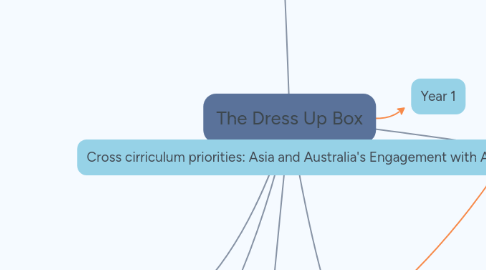
1. Speaking and listening
1.1. Active listening
1.1.1. Questioning
1.1.2. Turn taking
1.1.3. Effective communications
1.1.3.1. Oral recount/summary
1.1.3.1.1. Class discussions
1.1.3.1.2. Take turns when speaking and listening
1.2. Grand conversation
1.2.1. Comprehension
1.2.2. Exploring big ideas and think about how this makes you feel
1.2.3. Make connections with the story
1.2.4. Student centered
1.2.5. Read the book
1.3. Think alouds
1.3.1. Model, demonstrate
1.3.2. ex. "I wonder if the Frolleys wanted to move house?'
1.3.3. ex. "I think the big idea is change..."
1.3.4. ex. "Why do you think they were not happy to move?"
2. Gifted and talented
2.1. Extension
2.2. Development areas
2.3. Scaffolding
3. Cross cirriculum priorities: Asia and Australia's Engagement with Asia
4. Concepts
4.1. Theme
4.1.1. Purpose of the text
4.1.2. Change can be hard
4.1.3. What makes a house a home?
5. Writing and representing
5.1. Story boarding
5.1.1. Create another character from the dress up box
5.1.2. Create an imaginative text with a matching picture
5.1.3. Use interactive writing for the whole class and small group writing projects
5.1.4. Teach children to develop a single idea in their compositions
5.1.5. Write a letter to the Choongs, telling them about your new home
5.1.5.1. What information do you need?
5.1.5.2. Who is the audience?
5.1.5.3. Spelling
5.1.5.4. Punctuation
5.1.5.5. Verbs and adjectives
5.1.5.6. Edit and proof read
5.1.5.7. Create an image to match
5.2. t
5.2.1. Punctuation and capitalisation
5.2.2. Handwriting
5.2.3. Simple sentences that express single ideas and represent and dedscribe the who, what when, where, and why
5.2.4. Retelling the text
5.2.5. Sentence of the day
5.2.6. Descriptive adjectives
5.2.7. Teach contractions
5.2.8. Spelling
5.2.9. Re-reading work to improve meaning, spelling, and punctuation
5.2.10. Cut-up sentences
5.3. Recount
5.3.1. Cut-up sentences
5.3.2. highlight
5.3.3. Structure title
5.3.4. In the order it happens
5.3.5. Past-tense
6. Reading and viewing
6.1. Pre-reading
6.1.1. Explore the book
6.1.1.1. What is the title?
6.1.1.2. Who is the author?
6.1.1.3. Who is the illustrator?
6.1.1.4. What can you see on the cover?
6.1.1.5. What are the children dressing up as?
6.1.2. Make predictions about the story based on the cover and illustrations
6.2. Read the story
6.2.1. Demonstrate effective reading
6.2.1.1. Fluid and expressive reading
6.2.2. Highlight vocabulary and repetitive patterns
6.2.3. Reread: encouraging students to join in the process
6.3. Sketch to stretch
6.3.1. Readers theatre
6.3.2. Buddy reading
6.3.2.1. Fluency
6.3.2.2. Phonics
6.3.2.3. read-alouds
6.3.2.4. word knowledge
6.4. Word wall
6.4.1. High frequency words
6.4.2. Adjectives and verbs
6.4.3. Vocabulary
6.4.4. Important words
6.4.4.1. Word hunt
7. Additional texts
7.1. Anh Do
7.2. The Little refugee
8. Identify the book's purpose
9. Year 1
10. Participate in good conversations
10.1. Ask questions
10.1.1. ex. What would happen if?
10.1.2. Why do you think the author used that word?
